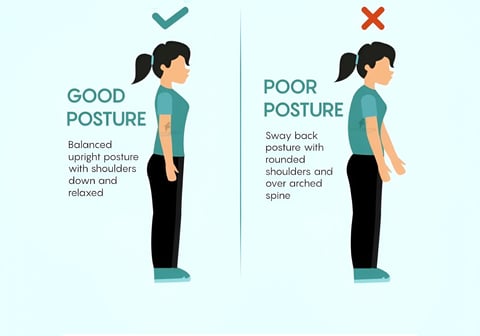

Good Posture vs. Poor Posture: How It Impacts Your Body and How to Improve It
Did you know that something as simple as how you sit, stand, and walk can have a profound impact on your health? Your posture plays a critical role in the well-being of your spine, muscles, and joints, and affects everything from your energy levels to your risk of chronic pain. In this post, we’ll explore the differences between good posture and poor posture, how they influence your body, and tips for improving your posture to boost health and comfort.
What Is Good Posture?
Good posture refers to the alignment of your body in a way that reduces strain on muscles, joints, and ligaments. When your body is properly aligned, your bones and muscles can support each other naturally, minimizing stress. Here’s what good posture looks like:
Standing: Your ears, shoulders, hips, knees, and ankles should be in a straight line.
Sitting: Your feet should be flat on the floor, your knees should be at a 90-degree angle, and your back should be supported by the chair with your shoulders relaxed.
Walking: Maintain an upright stance with your head up, your chest open, and your hips in a neutral position.
What Is Poor Posture?
Poor posture occurs when your body is not aligned properly, leading to increased strain and discomfort. It’s easy to fall into habits of poor posture, especially in today’s modern world, where prolonged sitting, slouching, and hunching are common. Examples of poor posture include:
Slouching: Rounding your shoulders forward and hunching your back while sitting or standing.
Forward head posture: Leaning your head forward, especially when looking at a screen.
Swayback posture: Pushing your hips forward while your upper body leans back.
The Impact of Good vs. Poor Posture on Your Body
Good Posture: The Benefits
Reduces Back and Neck Pain
Good posture maintains the natural curves of the spine, reducing the pressure on your back and neck. This can prevent the pain caused by muscle strain or spinal misalignment.Improves Breathing
When your posture is correct, your chest is open, and your diaphragm can fully expand, allowing for deeper and more efficient breathing.Enhances Digestion
Good posture allows your digestive organs to function properly by reducing pressure on your abdomen and intestines. Slouching can compress these organs and negatively affect digestion.Boosts Energy Levels
Proper alignment reduces the amount of energy your body needs to expend to maintain balance, leaving you with more energy throughout the day.Improves Circulation
Maintaining good posture encourages healthy blood circulation by preventing restricted blood flow that can happen from sitting or standing improperly.
Poor Posture: The Consequences
Chronic Pain
Poor posture, especially when sitting or standing for long periods, puts excess pressure on your spine and muscles, leading to tension, stiffness, and pain, particularly in the back, neck, and shoulders.Spinal Misalignment
Over time, poor posture can cause the spine to become misaligned, which may lead to conditions such as herniated discs or scoliosis.Reduced Flexibility
Slouching or hunching over for extended periods can lead to tight muscles and ligaments, reducing your range of motion and flexibility.Fatigue and Low Energy
Poor posture forces your muscles to work harder to support your body, which can lead to fatigue and decreased energy levels.Increased Risk of Headaches
Forward head posture and neck strain from poor alignment can contribute to tension headaches, migraines, and even TMJ disorders (temporomandibular joint dysfunction).
How to Improve Your Posture
Whether you’re working at a desk, relaxing at home, or walking, there are simple strategies to improve your posture and prevent the negative effects of poor alignment.
1. Pay Attention to Your Sitting Posture
Keep your feet flat on the floor with your knees at a 90-degree angle.
Sit back in the chair so your back is supported.
Ensure your screen is at eye level to avoid neck strain.
2. Stand Tall and Aligned
Stand with your feet shoulder-width apart and distribute your weight evenly on both feet.
Engage your core muscles and keep your shoulders back.
Avoid locking your knees, and keep your hips in a neutral position.
3. Practice Posture Exercises
Incorporating posture exercises into your routine can strengthen your core and back muscles, helping you maintain proper alignment. Some helpful exercises include:
Chin tucks: Strengthen your neck and help correct forward head posture.
Wall angels: Improve shoulder mobility and posture.
Cat-Cow stretch: Increase flexibility in the spine and relieve tension.
4. Use Ergonomic Furniture
Investing in ergonomic furniture, such as chairs with lower back support, standing desks, or footrests, can significantly improve your posture and comfort during long hours of sitting or standing.
5. Take Breaks
When sitting for long periods, take regular breaks to stand, stretch, and move around. Even a few minutes of walking can help relieve tension and prevent stiffness.
6. Consider Posture Correction Devices
There are a variety of devices on the market that can help remind you to maintain proper posture, such as posture-correcting braces or wearable devices that vibrate when you slouch.
The Importance of Good Posture
Good posture is more than just about looking confident or tall. It’s crucial for your long-term health and comfort. By maintaining proper posture, you can avoid chronic pain, reduce strain on your muscles and joints, and boost your overall well-being. If you’ve been struggling with poor posture, it’s never too late to start making small adjustments that can have a big impact on your health. So, stand tall, sit properly, and make your body’s alignment a priority for a pain-free and energized life!
Companio By Shree Tirth Wellness
Products
Accessories
Links
Get Connect
H-3, Ground Floor, Swaminarayan Avenue, Nr. Shell Petrol Pump, B/H Torrent Power, AEC Cross Road, Naranpura,Ahmedabad, Gujarat.
Pin Code -380013
© Copyright 2024 Shree Tirth Wellness.
All rights Reseverd
